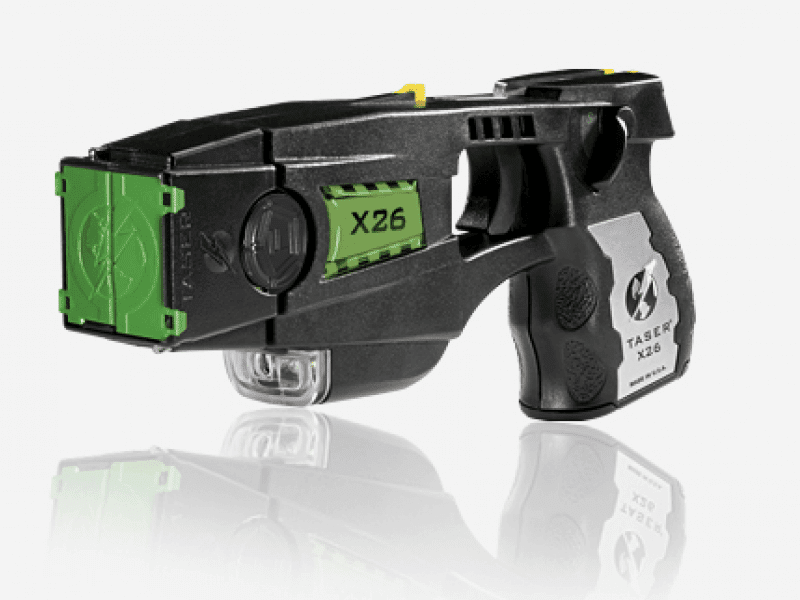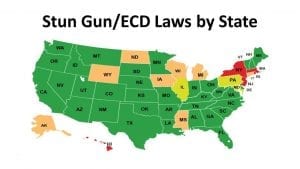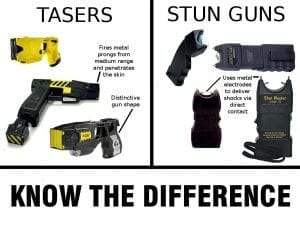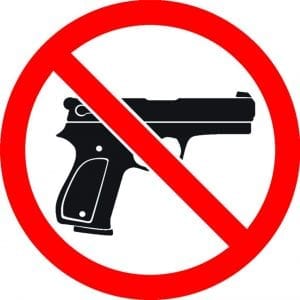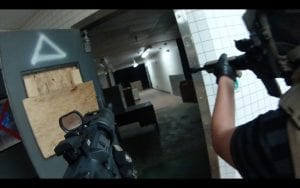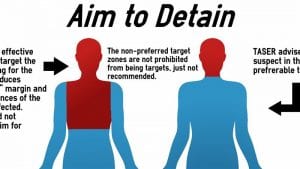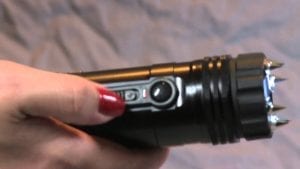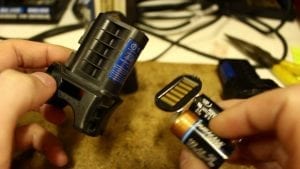How can a Taser gun help you? And how and when do you use it? Owning a Taser can spare not only you but also other people, from harm or death. Whether you’re a survivalist prepper, a guard, or someone in need of a self-defense weapon, a Taser makes an excellent addition to your arsenal.
There are many benefits of a non-lethal electric control device (ECD.) For example, the ability to incapacitate attackers in sensitive situations where a gun or pepper spray wouldn’t work. Sometimes, bad guys aren’t the only people you need to take out, and the ability to do so without unnecessary harm makes a world of difference.
More than 15,000 law enforcement agencies in over 40 countries around the world use Taser ECDs. Around 6,000 agencies use them as standard issue equipment.
Image via Patch.com
While the word is a registered trademark and refers to a specific product, to most people the word is synonymous with ECD, and tasing is an unofficial verb for their use.
Once considered a patrol weapon, these devices now serve various professionals, including:
- Mounted officers
- K-9 units
- Marines
- Correctional facility workers
- Tactical teams such as SWAT
In addition to the many professional uses, they’re legal self-defense weapons for civilians in most American states. Beyond the immediate use for self-defense, you can find many uses for electric weapons in tactical survival situations.
History of the Taser
The modern electronic control devices we see in use by police today are improved versions of the original Taser gun. NASA aerospace scientist Jack Cover (reportedly involved in the Apollo moon landing program) came up with the Taser while experimenting with electricity as a potential non-lethal weapon.
The origin of the Taser concept dates back even further, to 1911. The children’s book series “Tom Swift’s adventures” featured a futuristic weapon called the “Tom Swift Electric Rifle,” this is the inspiration for the name of the Taser. The full acronym saw the light in 1976 when Jack Cover grew tired of spelling out “T-S-E-R” every time he answered the phone.
Using the full name “Thomas A. Swift’s Electric Rifle” led to the easier-to-say acronym “TASER.” Over time, this became the common word used to refer to electrical weapons. Contrary to popular belief, Taser refers to a specific product by a specific company.
The First Taser
During the Watts riot in 1965, President Lyndon B. Johnson had a study done on the “free society” and related crime trends. In the finished study, there were recommendations for methods to handle unruly citizens. It declared that patrolmen should be equipped with “non-lethal” means of incapacitating criminals. It also had to be efficient while minimizing the risk of lasting injuries.
Image via Popsci.com
In the ‘60s, many patrolmen carried electronic cattle prods, known as “shock batons,” for effective crowd control. This caused an outrage and frequent accusations of cruelty and discrimination. Inventors made great haste, competing to come up with the best replacement for these shock batons.
Cover became inspired when he read an article in the newspaper where a man had walked into an electrified fence and, although he was mobilized for some time, survived without any harm. His original idea wasn’t very different from the competition at the time. These competitors’ ideas included air guns with electric projectiles and electrical long-range water guns. Both ideas were failures.
The Taser sent electrode projectiles that attached to a gun via thin wires. The weapon delivered a low-amperage, high-voltage electrical pulse able to subdue a person without harming or killing them. He got his patent in 1974.
A Safer Alternative
This early Taser propelled the electrodes with gunpowder. Due to this fact, the government classed it as a firearm, and it became hard to sell. Very few law enforcement agencies found the value of an electric firearm for their troops convincing. Some patrol supervisors would carry these weapons in their cars, but there was no widespread use. Cover tried to market it for other security purposes, such as protecting airplanes from hijackers.
In 1993, Cover teamed up with two brothers who helped him improve the device. Switching the gunpowder out for compressed nitrogen as a propellant made the “advanced” model more attractive. They released it in 1999, and police agencies started to adopt this new non-lethal weapon. When it became available to the wider public, sales exploded.
Many different ECDs have become popular since then, and the Taser is still one of the most common. Experts consider ECDs excellent tools that can protect offers and civilians from attackers without causing unnecessary harm. While there are some risks, a three-year study involving six law enforcement agencies found that 99.75% of shocked subjects suffered no serious injuries. Other than bruises, scrapes, and the probe marks, there’s no harm done.

Image via Usar.army.mil
ECDs have reduced the number of injuries to both officers and suspects, as well as citizen complaints.
How the Taser Works
Taser guns have two key functions in use-of-force encounters. The primary function is to serve as an incapacitation device, letting officers render threats incapable of causing harm from a safe distance.
Even the advanced modern technology of Tasers follows a simple concept. The device excites a compressed gas cartridge with electricity, and this propels two sharp metal probes. Thin copper wires connect the electrodes to the device and deliver a high-voltage electric charge into the target.
While the probes puncture the target’s skin in most cases, they can still deliver the charge if they get lodged in the target’s clothing, as long as they’re close enough to the body. Probe spread is far more important than full contact. The further apart the probes connect, the more effectively the device can incapacitate the target.
Electro-Muscular Incapacitation
The trajectory of the probes makes them spread on their way to the target. When they connect, they conduct eclectic pulses between them. This disrupts the neuron communications between the brain and the muscles. In the typical case, this causes strong, involuntary muscle tension. The official term for this effect is neuromuscular incapacitation.
As a result, the target becomes unable to control their muscle groups throughout the charge cycle. In the typical scenario, the target drops to the ground and lies there helpless. The effect ceases the moment the charge cycle ends.
The Taser doesn’t rely on pain compliance alone, although the Drive Stun mode relies on it. Because of this, law enforcement officers tend to favor Tasers over other ECDs, which may not affect individuals immune to pain.
Taser Gun vs Stun Guns:
While the word Taser is synonymous to Electric Control Device in most people’s minds, Tasers are only one of many types of electric self-defense weapons.
One of the most common types is the stun gun. These devices are legal in a majority of states and easy to purchase with no need for a license. However, certain states and cities put restrictions on their use, or prohibit possession altogether.
Image via Youtube.com
Tasers are also legal in general, although you may need a license, insurance, and proper training. Before you buy any kind of ECD, you should get an understanding of your local laws regarding their use.
The Differences between Tasers and Stun Guns
While the purpose of most electric non-lethal weapons is the same, there are major differences in how they achieve it, and how well. Here are the main differences between stun guns and Tasers.
-The price: You can get a stun gun for $15 and the price rarely exceeds $150. Tasers, on the other hand, start around $300 and may even cost more than $1,000 depending on the model and features.
-Operation: Stun guns only affect the nervous system. Tasers also disrupt the muscular system. The typical Taser can only fire once per cartridge, while a stun gun allows for repeated, continuous use until the battery runs out. However, Tasers can do the same thing in Drive Stun mode.
-Distance: Tasers let you incapacitate a target from a safe 15-30 feet. Despite the name, a stun gun requires you to get up close and hold it against the attacker’s body.
-Energy: Tasers deliver 50,000 Volt at 18 Watt of energy. Stun guns deliver up to 30,000 Volt with 14 Watt of energy.
-Size and Shape: Tasers look like guns and range between hand size and handgun size. Stun guns come in a variety of shapes and sizes. Some fit in your hand, some are large rods, others wrap around your hand like a set of brass knuckles. Certain types are disguised as cell phones or built into flashlights.
-Effectiveness: Repeated tests have proven Tasers to be almost 100% effective and, in fact, they have more stopping power than a 9 mm handgun. Stun guns are 86% effective on average.
-Deaths: There have been a number of cases where a Taser shocked a target to death. Stun guns haven’t caused a significant number of deaths.
-Availability: Tasers and stun guns are both available to civilians in most states. However, there are regulations and you may need a license. Regulations for Tasers tend to be stricter.
Image via Pinterest
Those are the key differences. It’s important to understand the pros and cons of both options, because they could save your life one day. It’s a good idea to get one of each.
Weapon-Mounted Tasers
One convenient option that allows for the combination of deadly and non-deadly force is to mount a Taser onto a firearm.
The most straightforward way to achieve this is to use an X-Rail mounting system. This lets you attach a Taser to the forward hand grips on any firearm that has a Picatinny-type rail system. It works like a vertical grip and aims wherever you aim the weapon.
This setup is very easy to use. There are only two simple steps. You can disengage the safety and then pull the trigger in less than a second.
There is one slight drawback, the potential risk of confusing the triggers. However, this is very unlikely, as the triggers are far apart and best used with different hands. Getting used to the setup shouldn’t take long, and it will be very convenient in tactical scenarios.
Another easy way to avoid this confusion is to dedicate a shotgun for non-lethal use, and mount the Taser on this weapon. This lets you choose between impact rounds and electricity for more versatile non-lethal stopping power and grants a longer range.
Tactical Uses for ECDs
There are many tactical situations where an electric control device is just what you need. Sometimes you need to defend yourself or incapacitate a target without using deadly force. This is useful, in particular, when dealing with someone who’s on your side but in a state of confusion, fury, or delusion.
Also consider the possibility of situations where you need to take someone out who has important information that you can’t get if they die.
Here are some of the scenarios where a Taser or other electric control weapon would really come in handy.
Sensitive Environments
There are many situations where firearms aren’t suitable. Many non-lethal weapons are also unfitting for certain environments.
Image via Govdocs.com
For example, indoor environments can restrict your options for both defense and attack. Chemical sprays are dangerous in these situations. Cross-contamination is a serious problem in enclosed spaces. The spray can affect you and other individuals who you don’t want to incapacitate. And if the location is a home or base, it can take a lot of sanitation after the threat is dealt with. Also, consider the time it may take to access and use the spray.
Due to these and other factors, chemical sprays are out of the question.
Launched impact weapons are often big and clunky, limiting your movement and requiring both hands. And there’s a minimum safe distance for their use. If you’re closer than recommended, you may cause serious injuries or even kill the target. This makes these weapons bad choices for tactical non-lethal force in enclosed spaces such as houses.
Even if lethal force is not a problem, firearms can cause too much damage to bystanders or the surroundings. Another danger this can bring in certain situations is the risk of causing leaks or explosions that could harm or kill you. Not to mention how the loud noises will let your adversaries know your exact location.
Why ECDs Excel
ECDs avoid all these issues and are ideal for such scenarios. The small size lets you navigate unhindered, and if you use a holster you can draw it in no time. In tactical situations requiring non-lethal force, this lets you act fast instead of calling for the designated non-lethal weapon.
There is no minimum safe distance with an ECD, and a Taser lets you shoot from up to 35 feet. There’s no risk of damage or cross-contamination and no harm to bystanders or team mates. The only risk is accidental incapacitation of someone who’s touching the target. This makes the Taser the ideal weapon for indoor combat.
Image via Youtube.com
If you’re operating in a crowded or enclosed space and you come across an uncooperative person or animal, you can put them down without harm in an instant with an ECD. If the subject continues to hinder your operation, another cycle is all it takes to keep them down. You can keep them down for as long as you need, whether it’s for the sake of moving a team, securing a building, or waiting for a custody team to take care of the subject.
Another advantage of a Taser gun is that almost everyone knows what it looks like. Any threat or uncooperative element you encounter is likely to know very well what it is what it can do to them. They may drop to the ground as soon as they see you pull it out and disengage the safety.
Crowd and Perimeter Control
Another big challenge you may face in tactical situations is holding down a perimeter. Subjects leaving or entering a structure or site of combat is unsafe for you and for themselves. They may hinder your success in a variety of ways, with or without intention.
They may stall your progress or hinder the advancement of a whole team. This can let enemies access tactical locations or weapons they otherwise couldn’t reach in time. It could also stop you from succeeding in many other time-sensitive tasks such as rescuing people or disposing of a bomb.
In these scenarios, lethal force is out of the question. The most common solution is using impact munitions. Whether it’s a shotgun or a 40mm launcher delivering the projectiles, they’re really good at knocking people to the ground from a distance.
However, they don’t always hit and, even when they do, they may not keep a subject down for long. If nobody’s there to control the fallen subject, it may take additional rounds to keep them incapacitated. One big problem with this is the serious injuries that often come with repeated hits from impact rounds.
Image via EPS.net
There’s also the minimum safe distance for these munitions. And physical confrontation and subjugation aren’t always an option.
Tasers can save you in these scenarios. It’s easier to take a subject out without unnecessary harm, and they’re less likely to get up after the neuromuscular shock than they would be after being knocked down. If they try to get up, delivering another charge is effortless and safe.
The downside of Tasers is their limited range. In most situations, though, this will not be a problem. In addition, the range of tactical ECDs increases as technology advances.
How to Use a Taser Gun
Tasers and other electric control devices such as stun guns are only effective self-defense tools if you know the right way to use them. If you haven’t figured this part out before you need to use it, you’re likely to fail at taking your target down. You may even tase yourself if you’re not careful.
Make sure to know all you need to know for optimal use. Here’s a quick guide on how to use a Taser.
Know Its Capabilities
Different Tasers have different features and specifications, but the general principle is the same. The probes must come into contact with the attacker and stay there in order to deliver an effective electrical charge. Knowing the distance you can shoot is crucial. You don’t want to guess and miss, and you must not wait until it’s too late out of fear of not reaching.
The basic Taser for civilian use lets you take a target down from up to 15 feet. But the experts suggest that the ideal firing distance is around 7 feet. This makes it easier to aim and hit the target where it’s most effective. It’s still far enough for the probes to spread and cause more effective incapacitation.
It’s a good idea to test fire it to get a better idea of how far it reaches. You should also learn your Taser’s stopping power, its safety features, and any other specifications. There’s a user manual enclosed with the device, it will be your best source of information.
Image via CEmarketing.net
Do a Spark Test
Each time you’re going to bring your Taser with you, first do a quick spark test. The spark test lets you see whether or not your Taser works right. The test is simple, just remove the cartridge, disengage any safety, then pull the trigger. You’ll notice visible and audible sparks by the tip of the weapon if it’s in working condition.
Know How and Where to Aim
The design of the device should make it obvious how to hold it. Just like a handgun. If you’re not familiar with proper gun handling, here are some pointers:
- Hold it with a firm grip, using both hands if possible. Keep your elbows at a slight bend.
- Place the your trigger finger of your dominant so that the trigger is in the center of the first pad of the finger.
- When you’re ready to fire, press the trigger in a smooth motion. Make sure to do this right so you don’t move anything else and miss the target.
- Pull the trigger all the way until you’ve confirmed the shot, but don’t squeeze your hand too hard or you’ll throw off your aim.
The torso is the best body part to aim for. Not only because it’s the easiest to hit and a low center of gravity. It’s also where the Taser will have the most effect. The trunk of the body connects to everything and lets the electricity spread the right way.
Also, remember that the wider apart the electrodes hit, the more incapacitating the charge will be. Aim somewhere between the upper chest and the hips. The head and neck are not safe targets due to the risk of piercing something vital or electrifying the brain.
Many Tasers have a built-in laser sight that make it easier to know just where you’re aiming. Use this to your full advantage and fire when the red dot is on the target’s torso.
Image via Standard.net
Drive Stun
If you do end up missing your shot and can’t reload in time, or if there’s a second attacker, it’s not quite over yet. Your Taser can act as a stun gun if you push the end of the device against the target’s body. This Drive Stun function makes your Taser work like a stun gun as long as you keep the device held against your target. However, you must be careful to ensure that the electricity doesn’t travel from your target’s body into yours.
Also, keep in mind that this mode of use relies on pain for compliance.
Safety Precautions to Take when Using an ECD
While modern ECDs are designed for easy, safe use, there are still certain risks involved. There aren’t any major risks to you as the user, but the point of these weapons is to incapacitate subjects without harm or death. This isn’t always a guarantee if you’re not careful with how you use it. Follow these tips to ensure safe use of your Taser.
Carry Backup Rounds
Remember that each cartridge only lets you shoot once. If you miss, that’s it. If you’re facing the risk of multiple threats, you can’t Taser them all. Law enforcement agencies often require officers to carry at least one backup cartridge. It’s in your best interest to apply this same rule to yourself.
Evaluate the Distance
If your target is out of reach or moving away, this isn’t the ideal weapon for the situation. Even if you’re trying to ensure minimum harm to the target, a shot to the leg or a thrown weapon may be your only viable option. On the other hand, if a target is up close or charging at you, pulling out your Taser and taking aim might take too long. Consider your options before reaching for your Taser gun.
Image via 360training.com
Start with a Warning
If you’re trying to minimize harm and conserve cartridges, always start with a warning whenever it’s possible. People know the threat of Tasers. Let them know that you’re about to use one on them. Shout and signal if necessary. In many cases, the target will surrender. This may also save you from criminal charges for using too much force.
Issuing a loud and clear warning will also let others around you what’s about to happen. This is extra important if there’s another person trying to subdue the target with physical force. It gives them a chance to back away and avoid getting shocked.
People You Should Not Tase
While the electric charge from an ECD is safe in general, there are certain conditions and individuals who can sustain serious damage from the electric shock. When trying to subdue targets without causing harm or death, avoid tasing the following types of people:
-Pregnant Women: The current from a Taser may cause a miscarriage or severe damage to both the woman and the fetus.
-Children and Elderly Individuals: Tasers are designed for use on healthy adults. A smaller or weaker body may not be able to handle the charge.
-People with Electronic Implants or Pacemakers: Electricity is likely to cause malfunctions and overloads that can kill a person.
-Individuals Carrying or Covered in Flammable or Explosive Gas: The electrical charge can ignite the fumes and cause a disaster.
-People in a Risky Position or Activity: For example, tasing a driver may cause a crash, and tasing someone on a ladder can end with a deadly fall.
It’s always in your best interest to keep the Taser as a backup plan rather than a first reaction. Always assess the target and the situation before using your electric weapon to maximize safety and minimize risk.
Make Sure It’s Legal
While an electric weapon can provide excellent self-defense against attackers, it can’t defend you against the law if you’re caught carrying this device where it’s illegal. The same goes for carrying a Taser gun without an appropriate license.
Image via Unitepolice.com
While most states allow ECDs, there are some exceptions. Tasers are illegal in NY, HI, MI, MA, DC, RI, and USVI. Certain other states require licenses. Cities and counties may also have more specific laws. Read up on your local laws, or your safety device can make you unsafe.
Qualities to Look for in a Good Electric Control Weapon
While the Taser is a specific product, different models have different qualities. It’s also good to compare them against other ECD options, and know what to look for in those as well.
-Voltage: The charge of a good Taser peaks at 50,000 Volt, although not all of this tension transfers to the body. The Wattage ranges between 7 and 26 Watt. Civilian Tasers are not as powerful as police grade devices. Other ECDs tend to deliver around 30,000 volt, which is still a formidable tension.
-Battery: Some Tasers use lithium battery packs that supply a limited number of firings, other models use rechargeable batteries. Other brands use similar batteries or simple disposable ones. Which solution suits you best is individual. If you want to prepare for a post-apocalyptic survival scenario, opt for the battery packs or disposable batteries. Recharging opportunities may be few and far between.
-Grip: Proper Taser guns have a standard pistol grip that suits most people. When looking at other brands, make sure the grip allows for easy use and has some kind of anti-slip coating.
-Electrodes: The electrodes must be sharp enough to puncture thick clothing.
-Light: Tasers and many other ECDs have an integrated LED light. Tasers also features a laser sight for easy aiming, this is an indispensable feature in a long-range ECD.
-Snatch Prevention: If you’re leaning toward getting an off-brand or a stun gun, look for ones with snatch prevention features. Some devices have plates that shock the attacker if he tries to take the device from you. Other designs wrap around your hand like a set of brass knuckles, this makes it hard to disarm you.
-Weight: The last thing you want in a tactical situation is to carry too much weight. It impairs your mobility, stamina, and much more. The lighter the unit, the better.
Image via Youtube.com
Accessories for Improved Tactical Use
While a taser gun is enough on its own for simpself-defensense, in a tactical scenario you need more from your electric weapon. The following accessories will give you an easier time in a threatening situation.
-Holster
The holster included in the typical Taser package is, in essence, just a pouch. It’s not good for quick drawing or carrying on a tactical vest. Other ECDs often come with no holster whatsoever.
A proper holster will make your much more effective. There are both first-party and third-party option that do the job very well.
-Batteries and Chargers
A single battery won’t last forever. In a survivalist scenario, you won’t be able to buy new ones and you may not get to recharge. You won’t regret buying backup batteries for your ECDs.
If you end up using rechargeable batteries, get an extra charger cord. These break all the time, a backup cord may save your life one day.
Image via Youtube.com
Conclusion
There you have it, all you need to know about Taser guns and Electric Control Weapons. These formidable self-defense weapons can help you in many tactical situations where you need to take a target down without causing death.
Now you know what to look for and how to use it. You’re one step closer to perfect preparedness.

